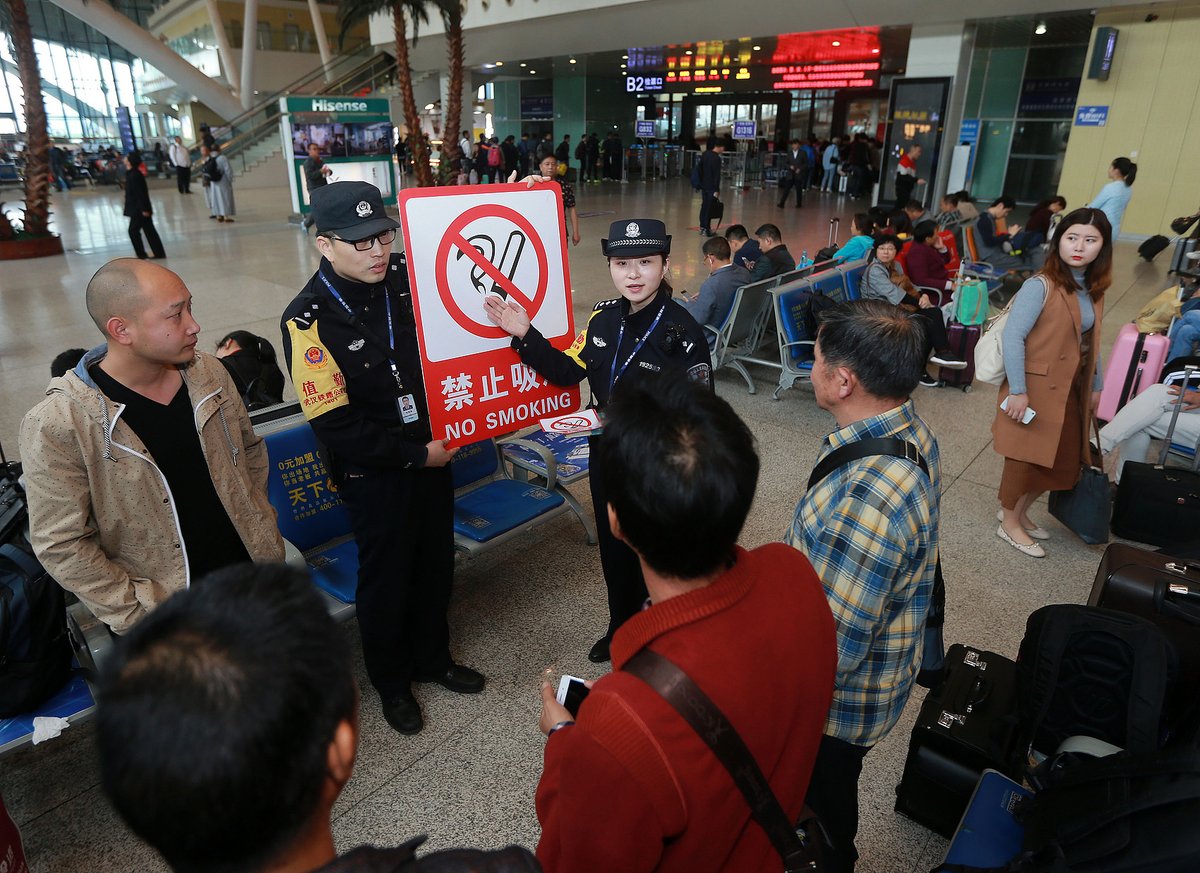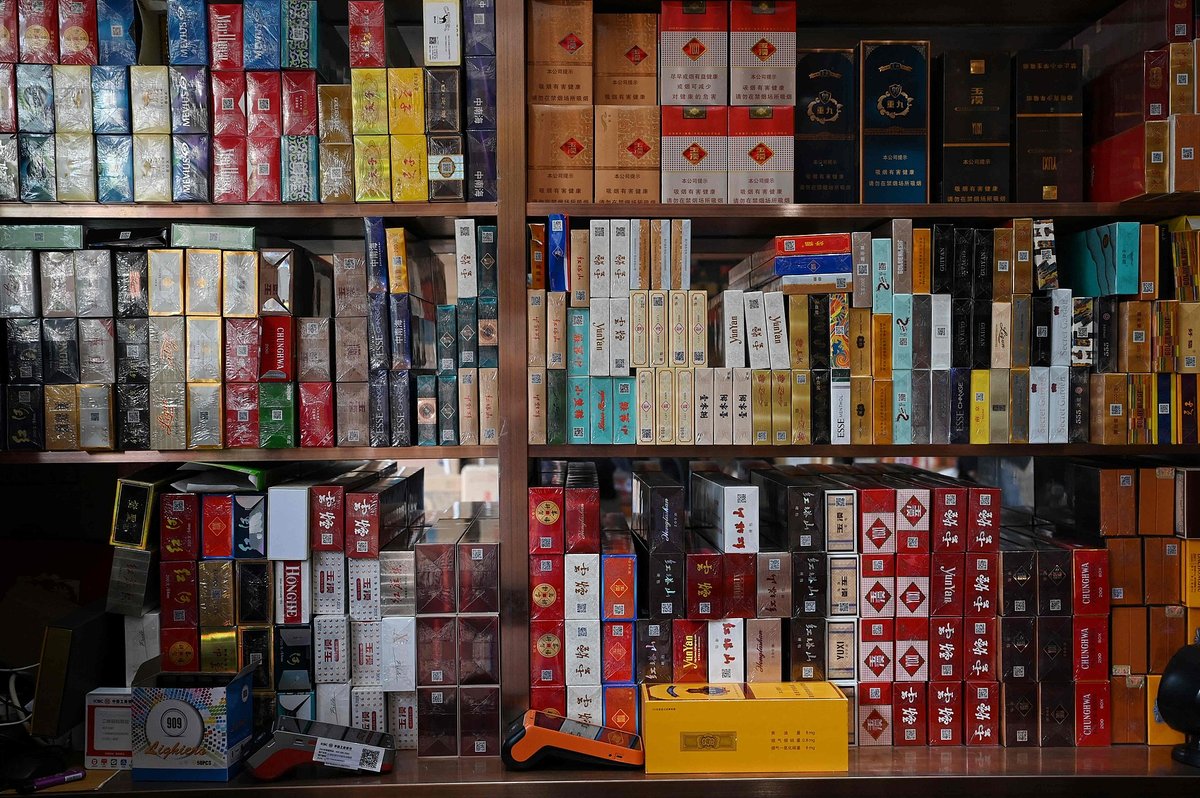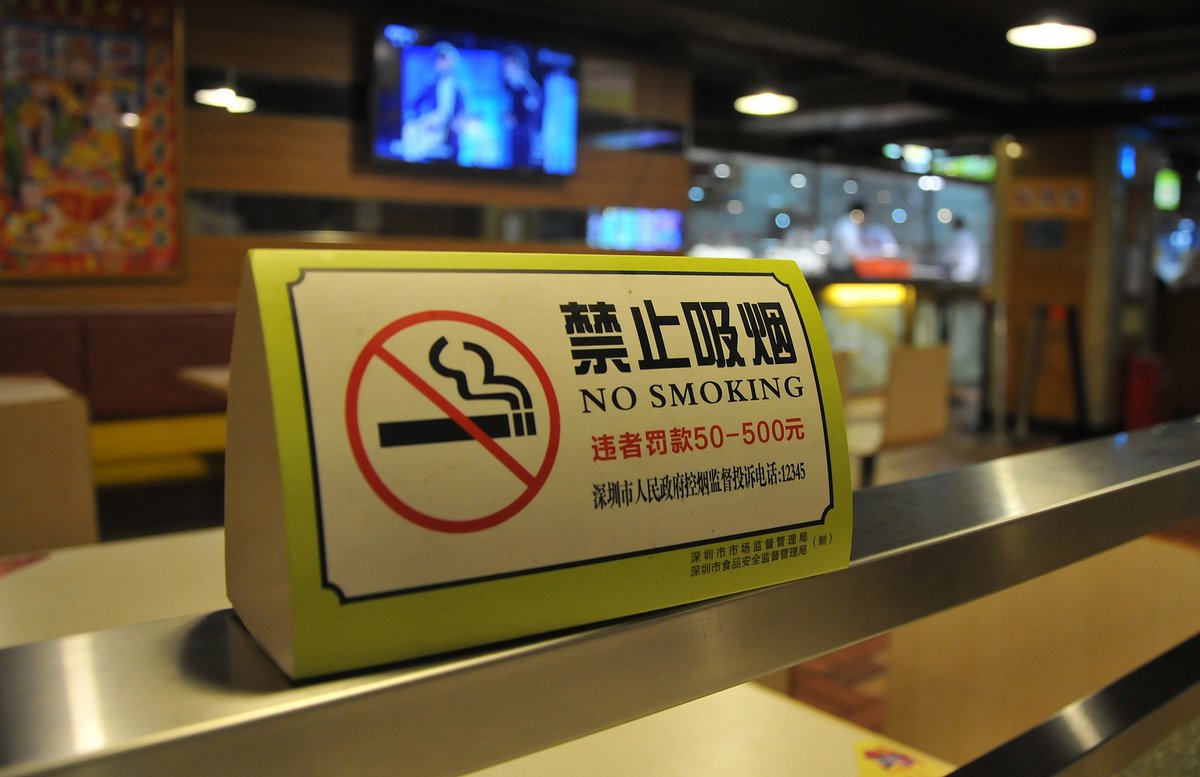Despite years of health campaigns and growing awareness of the dangers of secondhand smoke, smoking in public remains a problem across China. Now, with both government action and public pressure intensifying, are smoke-free environments finally within reach?
Xu Jiao was startled when a man stubbed his cigarette into her bowl at a Changsha restaurant while reaching for the phone she was using to film the encounter. The Chinese actress had been having lunch with her mother last December when they noticed the man smoking at a nearby table. After staff repeatedly asked him to stop, Xu confronted him herself, but he refused, claiming there was no no-smoking sign in the restaurant. Xu called the police, but they told her there was no legislation prohibiting indoor smoking in Changsha, so they couldn’t penalize him. When Xu posted the video on Weibo, it quickly sparked public debate. Many were shocked to learn that, while many Chinese cities have regulations on smoking in public spaces, there is no national law addressing the issue.
This is not the first time the topic has drawn national attention. Despite years of government campaigns and public pressure, banning smoking in public remains difficult, tangled in practical challenges and competing interests—from business owners wary of enforcement and pushback from smokers, to the discomfort of bystanders caught in between. Even in major metropolises like Beijing and Shanghai, where public smoking is banned, lax enforcement and vague definitions of “public area” continue to cloud the situation.
Read more about public health in China:
- Rethinking ADHD: Young Chinese Find Support and Strength in Safe Online Spaces
- The Thin Line: China’s Dangerous Boom in Extreme Weight Loss Techniques
- “I’m a Doctor, Not a Robot”: Seven Years in a Chinese ER
Smoking bans are nothing new in China. As early as 1839, Lin Zexu famously destroyed over a thousand tons of opium on the beaches of Humen, Guangdong province, in a determined act to resist British opium imports and curb the harmful substance’s grip on the country. Nearly two centuries later, official bans on public smoking similarly exist, yet tobacco use remains pervasive. Many netizens, troubled by secondhand smoke, now joke that they wish Lin could be resurrected to put an end to it. In reality, however, smoking is so deeply woven into Chinese social life that it figures into everything from business etiquette to family gatherings.
Today, over 300 million Chinese still smoke—more than 20 percent of people aged 15 and over. Over one million people die annually in China from smoking-related illnesses, including respiratory diseases, malignant tumors, cardiovascular and cerebrovascular conditions, and diabetes, according to a 2020 government report. While the rate of smoking among men (43.9 percent) far exceeds that of women (1.8 percent), the latter—as well as children—are not exempt from harm, as many are exposed to secondhand smoke.
As early as 2011, the Ministry of Health announced that “smoking is prohibited in indoor public places, and operators of such places must display prominent no-smoking signs.” As of May 2024, 24 province-level divisions have enacted tobacco control regulations, and 254 cities have introduced municipal-level regulations, according to data from the China Association on Tobacco Control for Health.
Yet the country continues to lack a unified national tobacco control law that specifies enforcement mechanisms and disciplinary measures. In 2014, penalties for violators were proposed but have yet to be officially adopted.
Beijing passed its official smoking control regulation in 2014, hailed at the time as “the strictest smoking control regulations in history.” It included a public smoking ban and penalties of up to 200 yuan for individuals and up to 10,000 yuan for venues.
Yet even business owners in the capital are still hesitant to intervene when patrons smoke in fear of losing customers and receiving poor reviews. Li, who works at a 24-hour gaming lounge in southeast Beijing and agreed to share only her last name, experienced this firsthand after confronting two customers who lit up indoors. The 24-hour gaming lounge, which rents out time on various consoles, has become popular among young gamers—and also attracts plenty of smokers, despite clear no-smoking signs and repeated staff reminders.
In an attempt to placate two regular smoking clients, Li upgraded their booking—offering a large private room at the price of a medium one—but the smoking persisted. Eventually, she suggested they go to a lounge where smoking was permitted. A few hours after they left, a bad review of her business appeared online.
“Most of the customers who come late at night are smokers,” Li tells TWOC. “For every group that lights up, I usually have to remind them twice—if not more—to put out their cigarettes. They flick ash on the floor and stub out their butts there, too.”
Unaware that Beijing has laws against indoor smoking, Li remarks, “People who smoke inside the store simply don’t care about the rules. I really wish there were fines for smoking indoors. ” Even after learning that fines can be imposed, she remains skeptical about enforcement. “The policy might give us more legitimacy to intervene,” she admits, “but my boss prioritizes customer satisfaction.”
Sometimes smoking control is even a point of contention among colleagues. Zhou, the property manager, who agreed to be interviewed under his last name, at a mall in central Chengdu, Sichuan province, notes that beyond designated smoking rooms, smokers often gather in less visible areas such as restrooms, fire escape stairwells, secluded backstreet corners, and the landscaped areas near loading docks.
Although these areas are technically non-smoking, Zhou estimates that over 70 percent of the mall’s staff smoke, making a complete ban difficult to enforce. His property management team has tried to crack down on indoor smoking—both for health reasons and to prevent potential fire hazards—including efforts to collaborate with the local police to issue warnings or even summonses when necessary.
“But we’ve met constant resistance from the operations and leasing departments,” Zhou says. “Safety should always come first—but when economic interests are at stake, it’s often pushed aside.”
A survey conducted earlier this year reveals that, despite the vast majority of Shanghai residents stating they dislike secondhand smoke, only 1.57 percent would dare to confront smokers directly. Most people said they instead opt to move away from the individual, and if they can’t, they simply endure the discomfort.
Part of the problem is an ambiguous definition of what constitutes “public space,” and the lack of clear regulations to back up complaints. This can lead to potential confrontation for people like Xu Jiao, who did take the initiative and speak out.
On December 13, 2024, just before Xu’s run-in, China’s State Council released an amended regulation that removed five types of venues—restaurants, inns, cafés, bars, and teahouses—from its list of public places governed by the Public Places Sanitation Management Regulation. The change took effect on January 20, 2025, sparking public confusion over whether these venues were still considered public places in the context of smoking bans.
In January, Professor Wang Qingbin of the Institute of Rule of Law at China University of Political Science and Law told Red Star News that the regulation’s scope is narrow, focusing mainly on sanitation management rather than the broader concept of “public spaces.” As a result, it offers no legal basis for routine tobacco control enforcement. He noted that regulators have avoided defining what constitutes a “public place” because a simple, commonsense understanding suffices, saying that it generally refers to any non-private space accessible to the general public. “This broader interpretation is necessary for effective tobacco control,” he explained, “… especially since it’s impossible to list every kind of public venue.”
In practice, however, many smokers themselves are uncertain about where smoking is allowed. “If someone tells me I can’t smoke here, I’ll stop,” says a smoker of nine years surnamed Xiong. “But if no one says anything, I’ll just keep smoking.”
Another major reason authorities have been slow to act is the cigarette industry’s close ties to the government. Tobacco taxation remains a major source of the country’s fiscal revenue, with the tobacco industry operating as a centralized, state-run monopoly. In 2024, cigarettes generated a total of 1.6 trillion yuan in tax and profit, marking a 5 percent year-on-year increase. And fiscal contributions reached 1.5 trillion yuan, up 2.8 percent from the previous year—both figures setting record highs.
In an interview with domestic outlet Yicai, Martin Taylor, the representative at the World Health Organization’s China office, emphasized that there is still considerable room to raise tobacco taxes in China, which at present only account for 52 percent of cigarettes’ retail price on average, significantly below the World Health Organization’s recommended benchmark of 75 percent.
“When local governments in China consider shifting their consumption-driven policies away from tobacco and toward other sectors—such as education, food and entertainment, sports, and health-related activities—it can yield greater economic returns in both the short and long term, while also supporting high-quality population development,” Taylor suggests.
The latest WHO report on global tobacco use also notes that while China has made strong progress in smoking-related monitoring, preventive measures, and public awareness campaigns, it must step up efforts in implementing comprehensive smoke-free regulations and improving health warnings on cigarette packaging.
In recent years, local governments have introduced more concrete enforcement measures, with top-tier cities leading the way in pioneering new approaches. Since March, Shanghai has piloted joint governance of outdoor smoking at eight popular landmarks, including the Bund, Wukang Road, and the Yu Garden. The initiative has garnered broad public support, with one highly-upvoted comment online reading, “It should be promoted across the country.” In June, Shanghai added 13 locations as part of the city’s second phase of outdoor secondhand smoke control pilot sites. Meanwhile, in Beijing, a decade of efforts under the city’s smoking control regulations has yielded notable progress: as of the latest data, only 19 percent of residents aged 15 and above smoke, marking a 4.2 percentage point decrease since 2015.
In some of the most smoke-polluted environments, especially restaurants, change is also underway. This May, the Beijing Food and Beverage Industry Association launched an initiative promoting “Smoke-Free Model Restaurants,” urging all dining establishments to eliminate smoking entirely, including in private rooms and on outdoor terraces.
A surge of social media posts in the past year has also called for stronger action against secondhand smoke. One influential account in particular, “Public Area Anti-Smoking Security Guard” (@公共场所禁烟保安) on Xiaohongshu (Rednote), has gained traction for its regular content of people sharing their experiences of confronting smokers in public.
Until last August, the account was simply a way for Lin, who agreed to be interviewed only under her last name, to document her daily life in Guangzhou. But one (since-deleted) post about her trying to stop a man at a neighboring table from lighting a cigarette, only to receive a strange look from the restaurant staff when she reported it, struck a chord with users and sparked an outpouring of support from people who shared her anger about secondhand smoke and frustration over the lack of law enforcement.
Moved by the unexpected encouragement online, Lin resolved to take action, researching relevant laws and publicly sharing information on how best to report indoor smoking violations. “(The ideal world) might take a very long time to arrive—so long that I can’t give a definite answer as to when it might be,” she tells TWOC. Lin added that since starting the account, she had called the government hotline nearly every time she visited a restaurant that allowed smoking, requesting authorities to fine the establishment. None of the reports led to a penalty. “Smokers are too coddled in our society,” she laments.
Several restaurants she visited in Guangzhou, Dongguan, Jiangmen, and Foshan did eventually take heed of her complaints, designating smoking and non-smoking areas and putting up no-smoking signs. While it’s a start, her fight to see meaningful change continues, going so far as to file complaints of negligence against the authorities themselves.
Xu, the actress, is also one of the account’s more than 15,000 followers. In a May interview with Portrait magazine, she said she was impressed by how diligently and systematically the account owner compiles relevant laws and complaint channels. Xu added that it inspires her to continue using her platform to speak out against public smoking.
“For me, this is more about wanting a better environment to live and work in. It’s my way of voting for the kind of world I want to see,” says Xu.
Is China Finally Moving Toward Smoke-Free Public Places? is a story from our issue, “Urban Renewal.” To read the entire issue, become a subscriber and receive the full magazine.

















